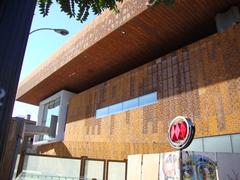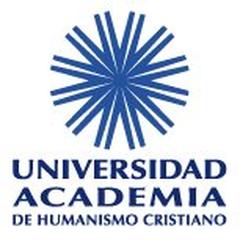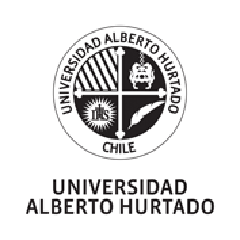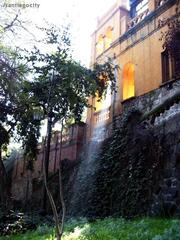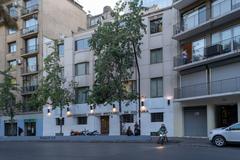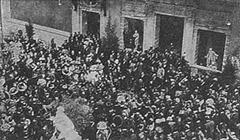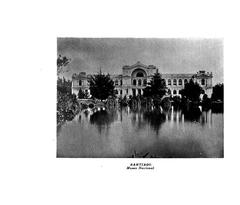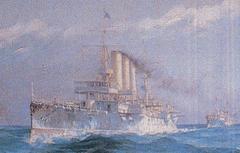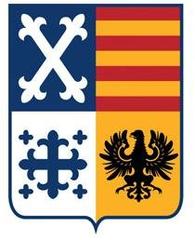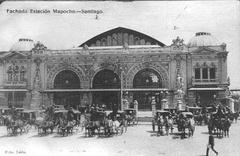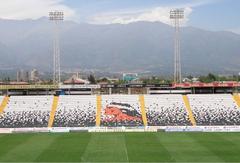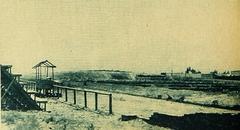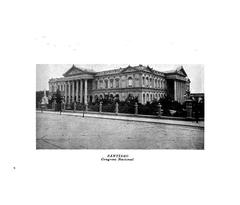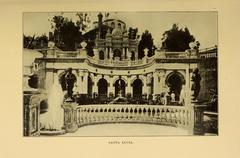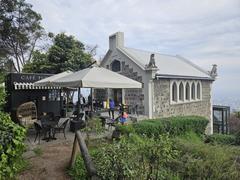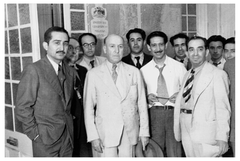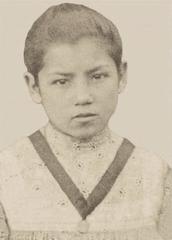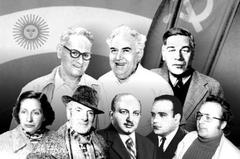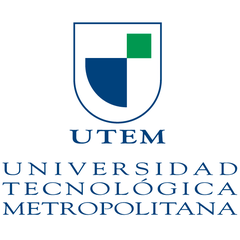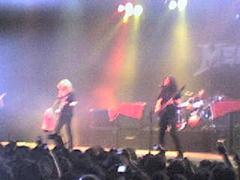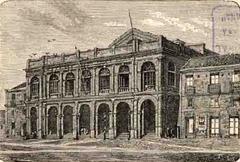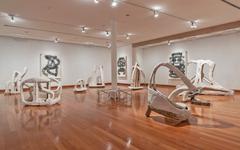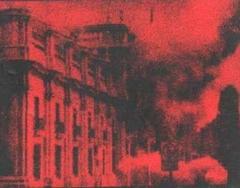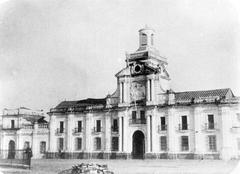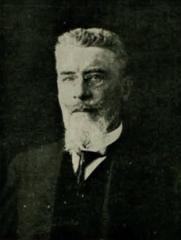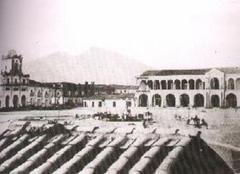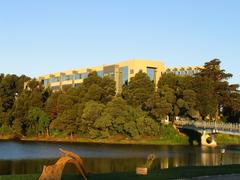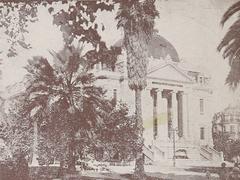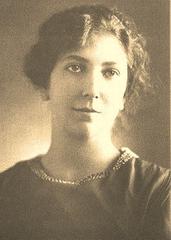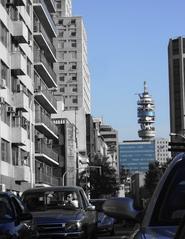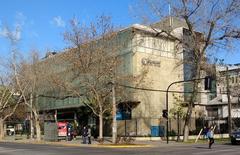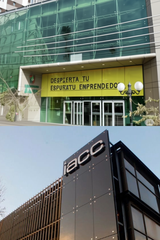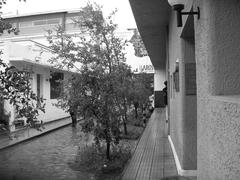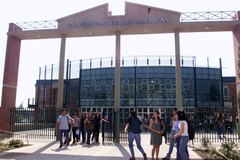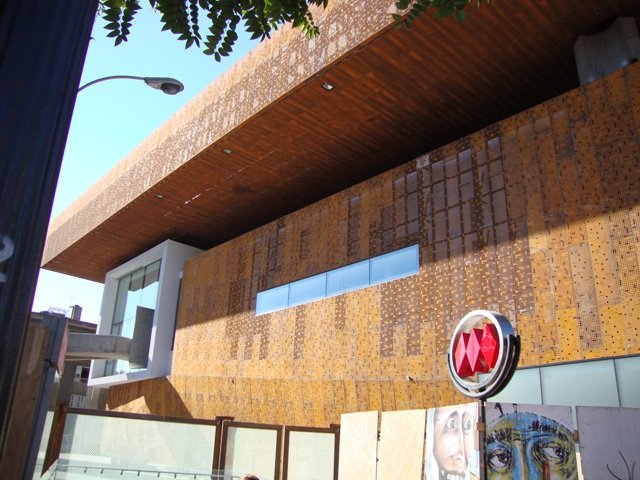
Centro Cultural Gabriela Mistral (GAM), Santiago: Complete Visiting Guide, History, and Attractions
Date: 14/06/2025
Introduction
The Centro Cultural Gabriela Mistral (GAM) is a landmark of Chilean culture and history situated at the heart of Santiago. Originally constructed in 1972 for the third United Nations Conference on Trade and Development (UNCTAD III), it has since evolved into a vibrant hub for the arts, education, and civic life. With its remarkable architecture and deeply layered past, GAM stands as a symbol of both the aspirations and resilience of Chilean society. This guide provides a comprehensive overview of GAM’s significance, practical information for visitors, and insights into its cultural programming and urban integration.
Table of Contents
- Introduction
- The Historical Journey of GAM
- Visitor Information
- Highlights and Attractions
- Symbolism and Collective Memory
- Honoring Gabriela Mistral
- Community Engagement
- Travel Tips and FAQs
- Summary
- References
The Historical Journey of GAM
Origins and Construction (1971–1972)
GAM’s story began when Chile was selected to host UNCTAD III, prompting the construction of a unique, modernist complex under President Salvador Allende’s administration. Built in just 275 days by thousands of volunteers, the building’s modular design and steel façade reflected the era’s optimism and progressive ideals (GAM History; Latin American Architecture UNM).
A Democratic Cultural Center
After the conference, the building was renamed in honor of Nobel laureate Gabriela Mistral and opened to the public as a center dedicated to democratizing access to the arts and education. This period was marked by a vibrant cultural scene, community engagement, and the strengthening of national identity (Arena Journal of Architectural Research).
Repression and Transformation (1973–1989)
Following the 1973 military coup, GAM was seized by the Pinochet regime, renamed Edificio Diego Portales, and converted into government offices and military headquarters. The building became a symbol of state power and repression, overshadowing its original mission (Wikipedia).
Renewal in the 21st Century
With the return to democracy in 1990, the building served various public functions but suffered from neglect until a fire in 2006 destroyed significant portions. Its restoration, completed in 2010, was guided by a vision of transparency, openness, and inclusivity. The renewed GAM now features theaters, exhibition spaces, a library, public plazas, and state-of-the-art cultural facilities (Supertravelr; Santiago Turismo).
Visitor Information
Opening Hours
- Monday to Friday: 10:00 AM – 8:00 PM
- Saturday and Sunday: 11:00 AM – 7:00 PM
- Closed on major public holidays
(For the most current hours, check the official website.)
Tickets and Admission
- General Admission: Free for most exhibitions and public spaces
- Special Performances/Events: Ticket required; purchase online or at the box office
- Advance Booking: Recommended for popular events
Accessibility
GAM is fully accessible, offering ramps, elevators, accessible restrooms, and services for visitors with visual or hearing impairments upon request. Its design prioritizes inclusion and ease of access throughout the 22,000 m² complex.
Location and Transportation
- Address: Av. Libertador Bernardo O’Higgins 227, Santiago, Chile
- Metro: Universidad de Chile (Line 1) and Universidad Católica (Line 1) stations are within walking distance
- Bus: Multiple lines along La Alameda (“Avenida Libertador Bernardo O’Higgins”)
- Parking: Underground parking at Villavicencio Street 354 (limited availability)
- Taxis and Rideshares: Readily available in the area
Highlights and Attractions
Architecture and Facilities
The design of GAM reflects a blend of modernity and historical memory, featuring exposed concrete, corten steel, glass, and wood. The complex comprises:
- Two Main Buildings: For performances, arts education, and exhibitions
- Ten Performance and Exhibition Halls: Hosting theater, dance, music, and visual arts
- BiblioGAM Library: A public library focusing on scenic and visual arts
- Five Open Plazas: Serving as gathering spaces for outdoor events and performances
Large glass walls and open plazas symbolize transparency and invite public participation (WikiArquitectura; GAM Official).
Arts and Cultural Programming
GAM is renowned for its diverse year-round programming:
- Theater: Acclaimed Chilean and international productions
- Dance: Contemporary, classical, and experimental works
- Music: Classical, jazz, popular, and experimental concerts
- Visual Arts: Rotating exhibitions, installations, and workshops
- Literature: Book launches, reading challenges, creative writing workshops
- Community Programs: Family games, outdoor yoga, senior activities, and artist residencies
- Festivals: Major events like the Festival Internacional Santiago Off and FindeFest
Guided Tours and Special Events
Free guided tours are available on weekends or by prior arrangement. Special exhibitions, festivals, and events are held throughout the year—check the GAM events calendar for details.
Nearby Attractions
- Lastarria Neighborhood: Known for its cafes, galleries, and boutiques
- La Moneda Palace & Plaza de la Constitución: Historic and political landmarks
- Parque Forestal & National Museum of Fine Arts: For art and nature lovers
Photographic Opportunities
- The oxidized steel façade and transparent glass walls
- Rooftop terrace with panoramic views of Santiago and the Andes
- Open plazas bustling with cultural and civic activities
Symbolism and Collective Memory
GAM is more than an architectural icon; it is a living testament to Chile’s turbulent history and ongoing pursuit of cultural democracy. The building’s transformation mirrors the collective journey from hope, through repression, to renewal and social justice. Its programming and open spaces foster dialogue, inclusion, and remembrance (Arena Journal of Architectural Research).
Honoring Gabriela Mistral
Named after Chile’s Nobel Prize-winning poet, educator, and feminist, GAM highlights Mistral’s legacy in literature, education, and social justice. Programs and exhibitions often address her pioneering work in advancing women’s rights and cultural identity (Academia.edu).
Community Engagement
GAM’s participatory initiatives—such as storytelling, oral history projects, and community art—strengthen its role as a platform for cultural innovation and social cohesion, engaging diverse audiences and preserving intangible heritage (Academia.edu).
Travel Tips and FAQs
Frequently Asked Questions
Q: Is there an entrance fee?
A: Most public spaces and exhibitions are free. Some special events and performances require tickets.
Q: What are the best times to visit?
A: Weekday mornings are less crowded; always check for special events.
Q: Is the center family-friendly?
A: Yes, with dedicated programs for children, families, and seniors.
Q: Are photographs allowed?
A: Generally yes, except where prohibited by exhibition signage or staff.
Q: How do I buy tickets?
A: Online at gam.cl or at the box office.
Travel Tips
- Explore the Lastarria neighborhood before or after your visit.
- Download the Audiala app for personalized guides and updates.
- Use public transportation for convenience and sustainability.
- Check social media for real-time announcements and highlights.
Summary
The Centro Cultural Gabriela Mistral (GAM) is a dynamic space where Chile’s past, present, and future converge. Its unique architecture, rich programming, and community orientation make it an unmissable stop in Santiago for culture lovers, history enthusiasts, and curious travelers alike. To plan your visit, consult the official GAM website for up-to-date information on hours, tickets, events, and accessibility.
References
- GAM History, 2025, Centro Cultural Gabriela Mistral Official (GAM History)
- Latin American Architecture UNM, 2025 (Latin American Architecture UNM)
- Arena Journal of Architectural Research, 2025 (Arena Journal of Architectural Research)
- Wikipedia, 2025, Centro Cultural Gabriela Mistral (Wikipedia)
- Supertravelr, 2025 (Supertravelr)
- Santiago Turismo, 2025 (Santiago Turismo)
- Academia.edu, 2025, Centro Cultural Gabriela Mistral Memories and Forgetting (Academia.edu)
- GAM Official Website, 2025 (GAM Official Website)
- WikiArquitectura (WikiArquitectura)
For more Santiago cultural guides and travel resources, visit our related articles or download the Audiala app for exclusive content.
